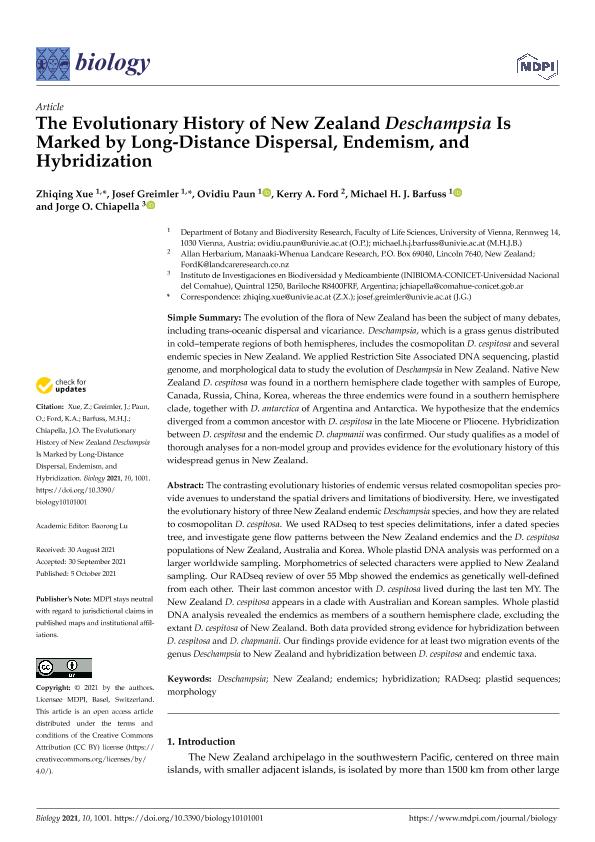Mostrar el registro sencillo del ítem
dc.contributor.author
Xue, Yali

dc.contributor.author
Greimler, Josef
dc.contributor.author
Paun, Ovidiu
dc.contributor.author
Ford, Kerry A.
dc.contributor.author
Barfuss, Michael H. J.
dc.contributor.author
Chiapella, Jorge Oscar

dc.date.available
2023-01-06T13:37:08Z
dc.date.issued
2021-10
dc.identifier.citation
Xue, Yali; Greimler, Josef; Paun, Ovidiu; Ford, Kerry A.; Barfuss, Michael H. J.; et al.; The evolutionary history of new zealand deschampsia is marked by long-distance dispersal, endemism, and hybridization; Multidisciplinary Digital Publishing Institute; Biology; 10; 10; 10-2021; 1-17
dc.identifier.uri
http://hdl.handle.net/11336/183699
dc.description.abstract
The contrasting evolutionary histories of endemic versus related cosmopolitan species provide avenues to understand the spatial drivers and limitations of biodiversity. Here, we investigated the evolutionary history of three New Zealand endemic Deschampsia species, and how they are related to cosmopolitan D. cespitosa. We used RADseq to test species delimitations, infer a dated species tree, and investigate gene flow patterns between the New Zealand endemics and the D. cespitosa populations of New Zealand, Australia and Korea. Whole plastid DNA analysis was performed on a larger worldwide sampling. Morphometrics of selected characters were applied to New Zealand sampling. Our RADseq review of over 55 Mbp showed the endemics as genetically well-defined from each other. Their last common ancestor with D. cespitosa lived during the last ten MY. The New Zealand D. cespitosa appears in a clade with Australian and Korean samples. Whole plastid DNA analysis revealed the endemics as members of a southern hemisphere clade, excluding the extant D. cespitosa of New Zealand. Both data provided strong evidence for hybridization between D. cespitosa and D. chapmanii. Our findings provide evidence for at least two migration events of the genus Deschampsia to New Zealand and hybridization between D. cespitosa and endemic taxa.
dc.format
application/pdf
dc.language.iso
eng
dc.publisher
Multidisciplinary Digital Publishing Institute
dc.rights
info:eu-repo/semantics/openAccess
dc.rights.uri
https://creativecommons.org/licenses/by/2.5/ar/
dc.subject
DESCHAMPSIA
dc.subject
ENDEMICS
dc.subject
HYBRIDIZATION
dc.subject
MORPHOLOGY
dc.subject
NEW ZEALAND
dc.subject
PLASTID SEQUENCES
dc.subject
RADSEQ
dc.subject.classification
Ciencias de las Plantas, Botánica

dc.subject.classification
Ciencias Biológicas

dc.subject.classification
CIENCIAS NATURALES Y EXACTAS

dc.title
The evolutionary history of new zealand deschampsia is marked by long-distance dispersal, endemism, and hybridization
dc.type
info:eu-repo/semantics/article
dc.type
info:ar-repo/semantics/artículo
dc.type
info:eu-repo/semantics/publishedVersion
dc.date.updated
2022-10-06T13:11:58Z
dc.identifier.eissn
2079-7737
dc.journal.volume
10
dc.journal.number
10
dc.journal.pagination
1-17
dc.journal.pais
Suiza

dc.journal.ciudad
Basilea
dc.description.fil
Fil: Xue, Yali. Universidad de Viena; Austria
dc.description.fil
Fil: Greimler, Josef. Universidad de Viena; Austria
dc.description.fil
Fil: Paun, Ovidiu. Universidad de Viena; Austria
dc.description.fil
Fil: Ford, Kerry A.. Allan Herbarium; Nueva Zelanda
dc.description.fil
Fil: Barfuss, Michael H. J.. Universidad de Viena; Austria
dc.description.fil
Fil: Chiapella, Jorge Oscar. Consejo Nacional de Investigaciones Científicas y Técnicas. Centro Científico Tecnológico Conicet - Patagonia Norte. Instituto de Investigaciones en Biodiversidad y Medioambiente. Universidad Nacional del Comahue. Centro Regional Universidad Bariloche. Instituto de Investigaciones en Biodiversidad y Medioambiente; Argentina
dc.journal.title
Biology
dc.relation.alternativeid
info:eu-repo/semantics/altIdentifier/doi/http://dx.doi.org/10.3390/biology10101001
dc.relation.alternativeid
info:eu-repo/semantics/altIdentifier/url/https://www.mdpi.com/2079-7737/10/10/1001
Archivos asociados
